You'll be living near some of the best roads in the country for a month, specifically those of western North Carolina. You can drive four different cars during this time. Would you make one of them a wagon?
I love wagons, and I did my best to make two of the four this endangered body style. Unfortunately, a Mercedes-Benz E63 AMG S became incapacitated (by an immovable object) a few days before I was to pick it up. This left the Volvo V60. The Volvo doesn't have the sheer thrust of the Mercedes, especially not in four-cylinder T5 form, but it has other charms.
For 2015 you'll find only three other wagons that aren't pretending to be SUVs on American dealer lots. One of them, the Volkswagen Golf Sportwagen, hadn't yet arrived, and is a much less expensive car. The Mercedes E-Class is a much larger, much more expensive car.
This leaves the BMW 328i as the V60's closest competitor. Though softer than in the past, the 3er remains the king of the premium compact hill. Why might someone buy the Volvo V60 instead?
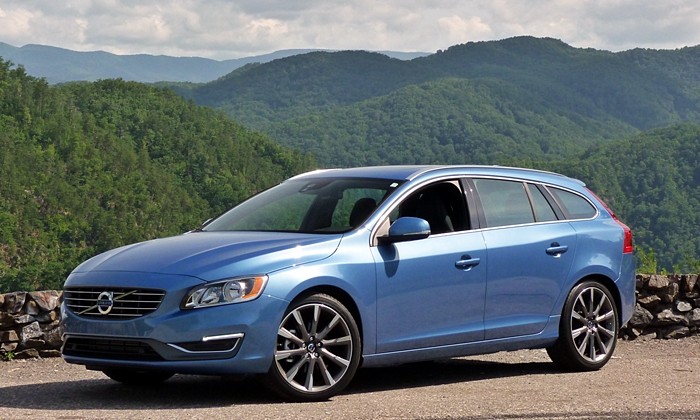
A handsome car from the front quarter, but not its best angle. more V60 photos
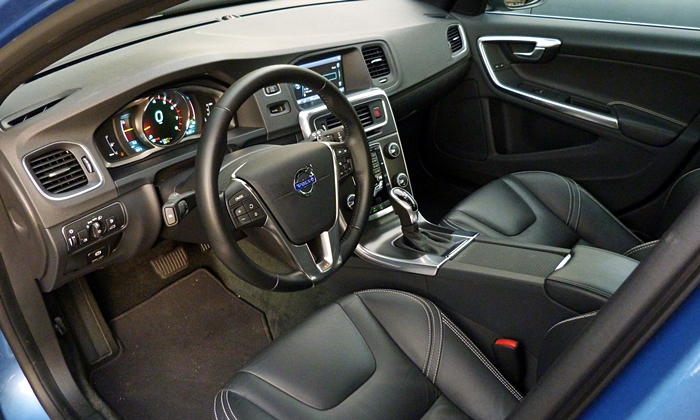
Warm and welcoming, even in black. Contrasting stitching helps.
| |
Compared to the 3-Series |
| Exterior styling |
 Better
Worse
Better
Worse
|
Say "Volvo," and many people think "safety" first and foremost. After all, the Swedish company spent decades with safety as its first priority and effectively advertising this first priority as its second priority.
At some point, after tens if not hundreds of thousands of people had needlessly died, the public started really caring about car safety. After the usual delay every major car manufacturer started putting serious effort into making their cars safer, adopting many Volvo innovations in the process. The end result: while Volvos remain very safe cars, with the latest safety features and top crash test scores, many competitors, including the BMW, now can claim the same.
Volvo realized its safety edge was ebbing away well over a decade ago. What to do? For starters, sell the car division to Ford (which ten years later sold it, at a huge loss, to Geely Automobile of China).
To be fair, other initiatives where initiated before the sale. For a long time Volvo's had not been styled in any conventional sense of the term. Part of their appeal to loyalists was the authenticity of their relentlessly spartan brick-like anti-styling. But there were not enough loyalists, especially not among the buyers of somewhat expensive new cars (Swedish labor is among the most expensive in the world). So Volvo gradually abandoned its zero-radius forms, starting with the semi-curvy midsize 1999 S80 and culminating with the radically swoopy (for a Volvo) compact 2011 S60.
The S60 used to have a wagon counterpart, the V70. But for 2008 the V70 grew in size, content, and price to align more closely with the S80 sedan. Three years later Volvo dropped the V70 from its North American line--though the quasi-crossover XC70 continues. These moves opened up space for a new S60-based wagon, the V60.
As might be expected given its S60 basis, the V60 is far from the traditional Volvo brick. If anything, it's more aggressively styled than the S60. Wagons don't have to be about function; freed of three-box conventionality, they can be sleeker than sedans.
With the V60, Volvo has realized this potential. Especially in powder blue metallic with the Sport Package's 19-inch wheels, this compact wagon is stunning. I could have photographed it from the rear quarter all day (you'll find three shots from this angle in the full gallery).
The BMW 3-Series remains an attractive car, but it doesn't inspire lust the way the V60 does. Its more conservative shape readily blends into traffic.
| Interior styling |
 Better
Worse
Better
Worse
|
To move upmarket, and better justify the prices of its cars, Volvo also upgraded their interiors. The V60's materials and finishes suit its $40k price. Its interior styling is clean, but not in the severe German fashion. Even in black leather the V60's cabin feels warm and welcoming. Go ahead, relax.
This said, one element strikes me as oddly out of place in the V60's otherwise thoroughly executed interior. Why does the center stack include two air vents that aesthetically clash with one another?
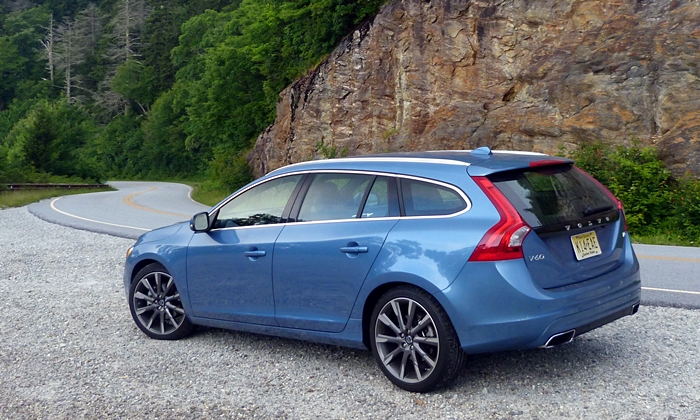
Great curves. Striking and lovely from the rear quarter, especially in this color with these wheels.
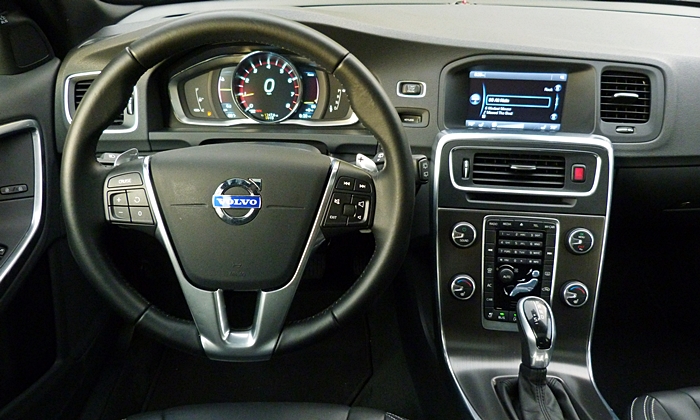
Configurable LCD instruments. Plus good large knobs, not so good large buttons.
| Front seat support & comfort |
 Better
Worse
Better
Worse
|
The V60's interior doesn't only look comfortable. Even back in the day Volvo's cars weren't known only for safety. Many people considered their seats the best. Many still do. The V60's front seats are much cushier than those in a German car, but they are also properly supportive.
One caveat. Locate the headrest to receive top scores from the crash test dummy and it will jut too far forward for people with especially upright postures--like me. "Active headrests" that move forward if and when the car is rear-ended can sidestep this tradeoff. But the V60's active headrests do not.
The BMW's seats are much firmer, but their headrests have a fore-aft adjustment. You also sit significantly lower in the BMW, but its instrument panel isn't as deep (owing to its windshield being more upright), for a more open view forward.
Your build and impressions of either car's seats may vary.
| Fuel economy |
 Better
Worse
Better
Worse
|
Recently Volvo launched a serious push to improve its cars' fuel economy. For 2015 the five- and six-cylinder engines in its front-wheel-drive models have been replaced by a new four-cylinder engine. The benefit? Fuel economy for the related S60 T5 sedan improved from 21 mpg city, 30 mpg highway last year to 25 / 37 this year. The new numbers are the best for any gasoline-powered car in the segment. The BMW 328i checks in a couple mpg lower on each test. The 328i wagon, hindered by standard all-wheel-drive, manages "only" 22 / 33 (still impressive figures for such a quick car).
Volvo's new engines include a start / stop function that automatically shuts off the engine when the car isn't moving, then automatically restarts it when you lift off the brake. This system operates far more smoothly than BMW's initial attempt, but might still annoy some people. They can hit a button to deactivate it, but they'll have to do this every time they start the car.
Since I wasn't at home while testing the V60, I can't compare its real-world fuel economy to that of other cars I've tested. On a twisty rural road the Volvo's trip computer reported 24.8 mpg. On a 70-mph highway it reported 32.5 mpg, well short of the EPA rating. At a lower speed it might have matched the rating.
| Price or payments |
 Better
Worse
Better
Worse
|
The Volvo V60 isn't an inexpensive car. The moderately optioned test car listed for over $42,000. But a similarly equipped BMW 328i costs another $7,725. Adjust for the BMW's additional content, chiefly all-wheel-drive, and the Volvo retains an over $4,500 price advantage.
| |
Compared to the 3-Series |
| Cargo capacity |
 Better
Worse
Better
Worse
|
Back when Volvo wagons were boxy, they could swallow vast amounts of cargo. Owing to its downswept roofline and curt rear overhang, the V60 doesn't remotely approach the capacity of those wagons. The maximum cargo volume spec--44 cubic feet--doesn't quite match that for a Ford Focus hatchback. Even the BMW is rated to hold another nine cubes. The Jetta Sportwagen: another 23 (tying the Volvo XC60 crossover).
To be fair, the V60's cargo space appears modestly more voluminous than the spec suggests, and not too far off the BMW's (the main difference being the latter's higher rear roof). VW likely used a different method to arrive at its much larger spec, one even the much larger E-Class wagon doesn't approach. But no matter how you measure the V60 there's not an abundance of cargo space. Volvo's newfound style has a non-monetary price.
Then again, many people won't need the cargo area for much other than groceries and the occasional luggage. It's large enough for these tasks. And the tailgate is handier than a trunk will ever be.
| Rear seat room & comfort |
 Better
Worse
Better
Worse
|
The Volvo V60's rear seat space also lags the BMW's. At 5-9 I can sit behind myself with a couple inches to spare, but subjectively the limited space seems even tighter than it is. The side window outline that appears sexy from the outside can seem confining from the inside. Large front seat headrests block the view forward. Behind a tall driver even adults of modest size will feel cramped, if they can fit at all.
The BMW wagon has a little less headroom but a couple more inches of much-needed knee room. Also, while the Volvo's cabin is a couple inches wider than the BMW's up front, and feels much roomier as a result, this advantage disappears in back.
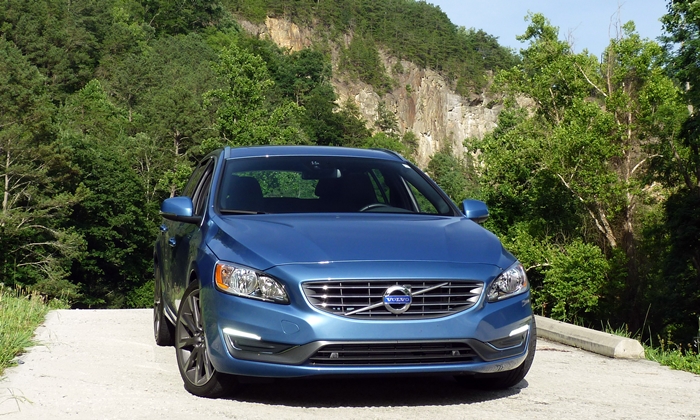
Volvo hasn't hopped on the fierce face or the big grille bandwagon. Friendlier?
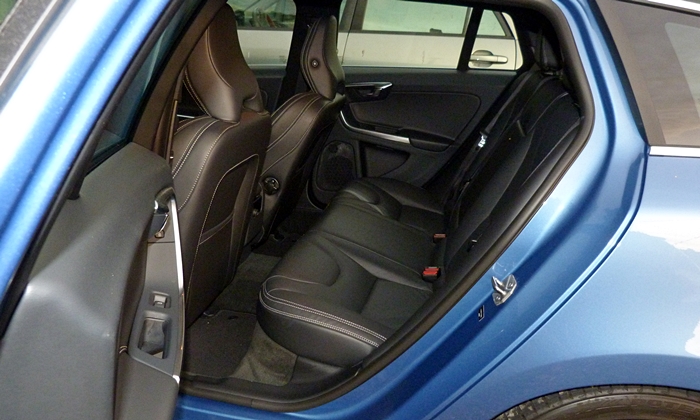
Rear seat room was not a top design priority.
| Ride smoothness |
 Better
Worse
Better
Worse
|
The roads of North Carolina are far smoother than those of Michigan. Even so, I was surprised by the firmness of the Volvo V60's ride. BMW is hardly known for cushy suspension tuning, but even the 328i takes the edge off bumps better. If you live where the roads are far from perfect, you should probably skip the V60's Sport Package with its firm suspension and 235/40WR19 rim protectors. A shame, as the large rims do look great on the car.
| Quietness |
 Better
Worse
Better
Worse
|
The amount of road noise entering the Volvo V60's cabin on some highways was an even bigger surprise than the firm ride, and it'll be there no matter which boxes you check on the option sheet. I could easily live with this noise, but many premium car buyers are more sensitive or less forgiving.
| |
Compared to the 3-Series |
| Powertrain performance |
 Better
Worse
Better
Worse
|
If you want a thrillingly quick Volvo V60, get the T6 R-Design, which has a 325-horsepower turbocharged 3.0-liter inline six-cylinder engine powering all four wheels. But the T5 Drive-E (the latter bit denoting the new engine) is far from slow. Like the 328i's motor, Volvo's latest is a turbocharged, direct-injected 2.0-liter four-cylinder good for at least 240 horsepower (the BMW's rating seems conservative, while the Volvo engine has an overboost function that can provide additional oomph for up to ten seconds). Both engines are hitched to eight-speed automatics, though the Volvo's drives only the front wheels while the BMW's drives all four. (You can also get the Volvo with all-wheel-drive, but not with the new, more efficient engines.) If you want a manual transmission in either car, you're SOL in the USA. Either car can sprint from a dead stop to 60 mph in under seven seconds without a tire-shredding launch.
While the stopwatch reports similar performance, the driving experiences differ. The Volvo engine is much more obviously turbocharged. After you press down your right foot you'll sense some lag, after which you'll feel and hear the boost kick in. In the BMW, you'll notice no lag and won't hear the turbo spin up. The BMW engine also sings a more interesting song in lower notes. The Volvo's sound is much more that of the typical four. For this and other reasons, exploring its upper range isn't as enjoyable.
The combination of a powerful engine with front wheel drive can yield light, darty steering and even a tug to the side during hard acceleration. The Volvo suffers little from such torque steer. More of an issue: it's too easy to spin a front tire if you try to accelerate before fully exiting a curve.
| Handling |
 Better
Worse
Better
Worse
|
Especially at first, the Volvo V60's steering felt too quick and too light, though it did seem to firm up when this was most needed. After a few hours I adapted, but firmer, more communicative steering on a more consistent basis would inspire more confidence.
It fell to the Sport Package's Bridgestone Potenza summer tires (size 235/40WR19) to inspire confidence. These grip tenaciously in hard turns. Typical of nose-heavy front-wheel-drive cars, the V60 steadily understeers, so the outside front tire is always the first to lose its grip, and then safely and gradually. No tricks to beware of here. Combine this predictable grip with the minimal amount of roll permitted by the firm suspension, and the V60 was easily up to tackling the famed, ultra-twisty Tail of the Dragon (NC 129). Crossovers, with their higher seating position and center of gravity, can't handle like this. I had a lot of fun driving the V60.
Then, after arriving in Asheville, I drove the BMW 328i wagon for sake of comparison, and this comparison drive did what it was supposed to do. Even on suburban roads it was instantly obvious that the BMW feels much more balanced and lively. This isn't the contradiction it might seem. Because the BMW's weight distribution is much more balanced, and because its suspension is tuned to take advantage of this inherent balance, there can be more variation in how it behaves. An all-wheel-drive system with a bias towards the rear also helps render the 328i far more tossable than the V60. It dances in ways the Volvo cannot.
The BMW also feels lighter (though it's actually about 250 pounds heavier, 3,780 vs. 3,527) and more compact (which it is, with two inches less width and far less instrument panel between you and the outside world). Finally, as much as I've criticized the latest 3-Series for insufficient communication and lapses in body control, it beats the V60 in these areas.
On "the Dragon" I'd have had even more fun in the BMW.
| Reliability & durability |
 Better
Worse
Better
Worse
|
With both Volvo and BMW a quick search will uncover no shortage of reliability horror stories. Their latest cars have been better, if still worse than average. Unfortunately it's too soon to tell how well they'll hold up after the warranties end.
America perceives wagons as old-fashioned and boring, and has nearly killed them off. If there's any justice in the automotive universe, the new Volvo V60 will avert the segment's extinction. The new wagon looks stunning, has a welcoming Scandanavian-design interior, and, despite a chassis that's not as lively as the BMW's, it can be great fun to drive. Crossovers cannot handle as well, because physics.
Yes, Volvo has sacrificed quite a bit of rear seat and cargo space in crafting the V60's killer body, but what remains should be sufficient for all but tall people nearly all of the time. Also, the V60 isn't entirely impractical. It's safe, its seats are very comfortable, and its fuel economy (in Drive-E form) is best-in-class.
Consider me charmed.
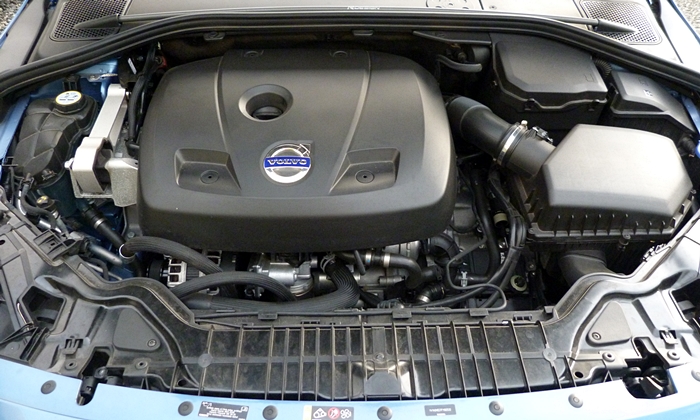
Volvo's new turbocharged four-cylinder engine is powerful and efficient.
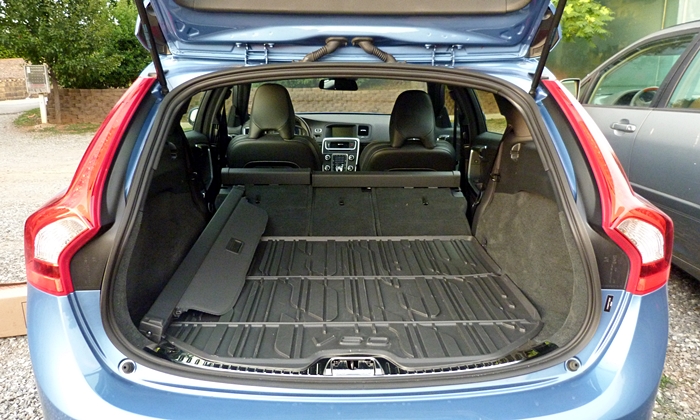
With the seats folded, the cargo floor isn't nearly flat.
See more 2015 Volvo V60 photos
Volvo provided an insured car for a week with a tank of fuel. Joshua Moniz at BMW of Asheville helpfully provided a comparison test drive. They can be reached at. 828- 231-9900.











